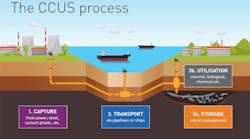Editor's note: This column first appeared in the March-April 2023 issue of Offshore magazine. Click here to view the full issue.
By David Paganie, Houston
Oil and gas operators have been progressing strategies to reduce the greenhouse gas (GHG) emissions that are under their direct control. There certainly has been a sense of urgency in the past few years, and data suggests that those efforts are having a positive impact. The gap, perhaps, is in the tracking and reduction of indirect emissions (scope 3), as that requires a comprehensive evaluation of full value chains to understand the impact on operations.
In the meantime, most of the operators in the industry have outlined strategies to reduce direct GHG emissions (scopes 1 and 2). The approaches vary by company and include carbon, capture, use, and storage; electrifying assets via power from shore or offshore wind turbines; flare optimization technology; zero-leak valve management; fugitive emission reduction; and investments in green and blue hydrogen and renewable energy. The ladder is viable mainly for the larger operators that have value chains to support a new business integration.
Companies use various metrics to determine the feasibility of a project. A common metric used to compare and screen opportunities based on their carbon competitiveness is GHG emissions emitted per amount of hydrocarbon produced. This metric is referred to as GHG intensity. It reflects the overall emissions from the development over the life of the asset or field. For new projects, the metric is evaluated at different phases of a stage-gated process to determine if it will meet low-carbon objectives.
Independent Project Analysis (IPA) reviewed data from more than 40 ongoing projects (pre- and post-FID but not operational yet) and found that there is a trend in the improvement of the carbon competitiveness of projects. The projects in the planning phase that are expected to be authorized in 2023 are, on average, 45% less carbon intensive compared to projects authorized in 2016, according to the study. IPA suggests that this emerging trend highlights the growing integration of GHG intensity improvement through the early definition phases of project development.
The research and consulting company’s study finds that the GHG performance of the opportunity is driven primarily by the hydrocarbon type (ratio of gas and oil produced), reservoir and fluid characteristics, and concept selected to develop the reservoir.
Click here to read IPA’s full review of its GHG performance evaluations.
This focus on the integration of decarbonization technologies and techniques is also reflected in Offshore’s Top 5 projects to watch this year. The selection criteria included the application of renewable energy components or emissions reductions technologies. Bruce Beaubouef, Offshore managing editor, reviews the top projects.
Operators are looking to decarbonize with late-life assets as well. This is the strategy of independent Neptune Energy. The operator’s approach to decarbonization is to extend the life of its offshore assets and repurpose them to facilitate CO2 storage and hydrogen production by using domestic, lower carbon-intensive gas or wind power. Neptune suggests that by extending field life, electrification could become more economic and help to decarbonize existing production. Ariana Hurtado, Offshore editor and director of special reports, spoke with Neptune and other operators, contractors, suppliers, and consultants for an update on the oil and gas industry’ decarbonization strategies. Click here to view the 2023 Energy Transformation Strategies Special Report.









